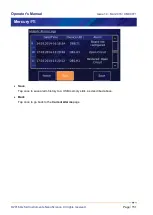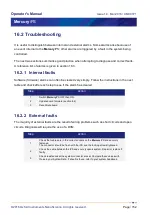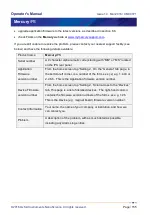
Operator's Manual
Issue 14
/
Mar 2016 / UMC0071
Mercury
iPS
©2016 Oxford Instruments NanoScience. All rights reserved.
Page
140
3
Ratiometric Voltage
sensors normally provide an output 0-100mV (for 10V excitation)
referenced about GND_A. This results in 0-20mV at the ADC. The ADC internal PGA will be
set to a minimum gain of 8 with auto-ranging and the measurement is made as described in
the Absolute Voltage case described above. The excitation voltage is measured exactly by
the EXCI and EXCITE_VMON- signals feeding the MSP430 ADC12. The
voltage fed to the system is normalised as if the excitation voltage were precisely 10.0V and
the pressure is determined with reference to the Transducer Calibration Table.
13.2 Installing a pressure board
13.2.1 Fitting the board
A pressure board can be fitted in any expansion slot (except GPIB slot).
The procedure for fitting a daughter board has already been described in section 7.2.
13.2.2 Basic check of board operation
1 Power up the
Mercury
iPS. If fitted correctly, the iPS will detect the board and may request
permission to use it.
2 Put the iPS in Local mode by tapping the local/remote toggle button on the iPS
Home
page.
3 Tap
Settings,
scroll to and tap the
Devices
tab.
4 Scroll down the list of devices and find the level meter board. Also, scroll to the right to read
the firmware version.
13.2.3 Connecting to the pressure board
The pin connections for the 9-way D connector on the pressure board are listed in the table
below.
Pin
Name
Function
1
Sense +
High Impedance transducer Input +
2
Sense -
High Impedance transducer Input -
3
Resisto
4-20mA current Sense Resistor – Sense+
4
Exci
5
Excitation -
6
()
7
(Heater -)






























